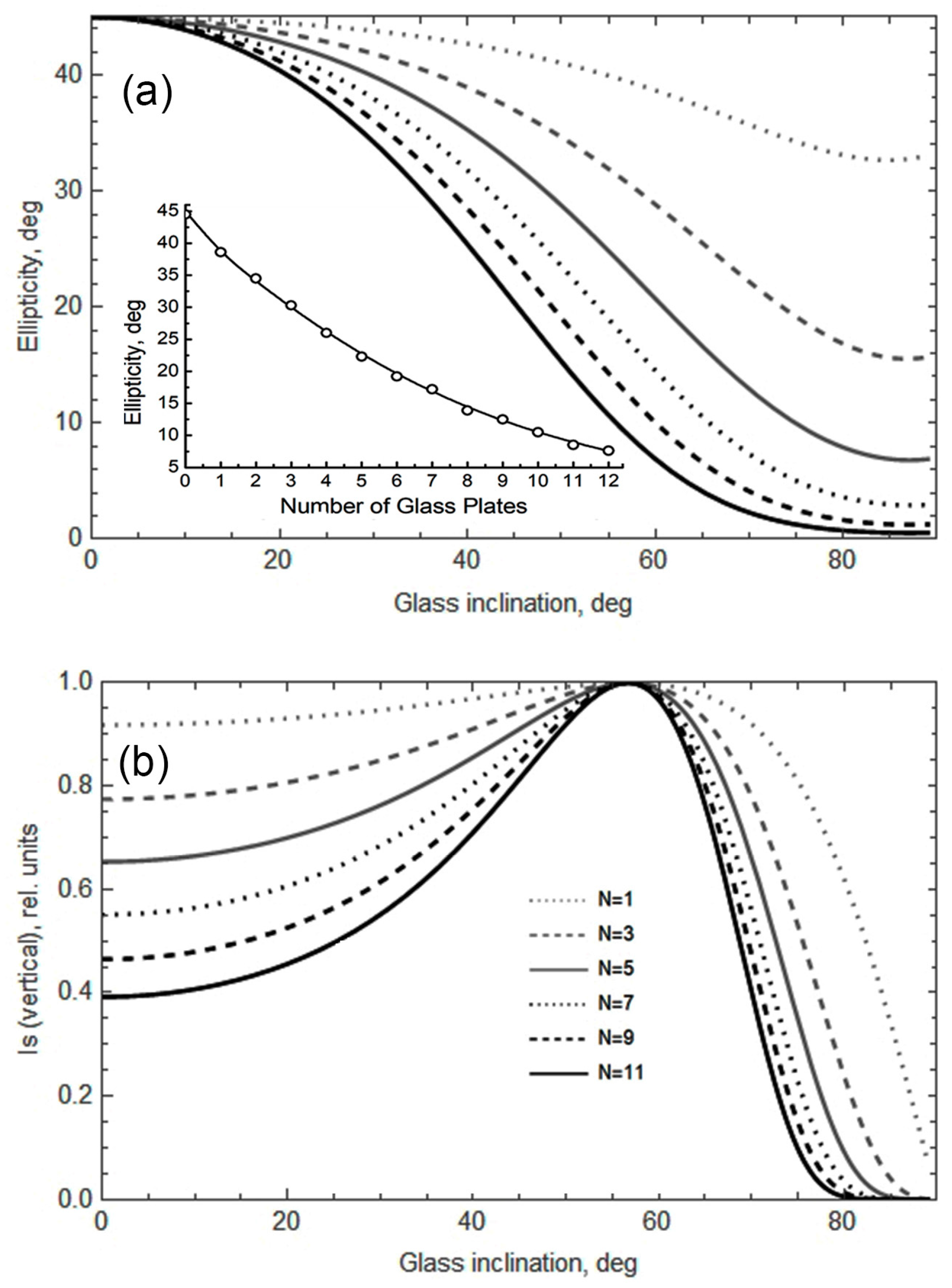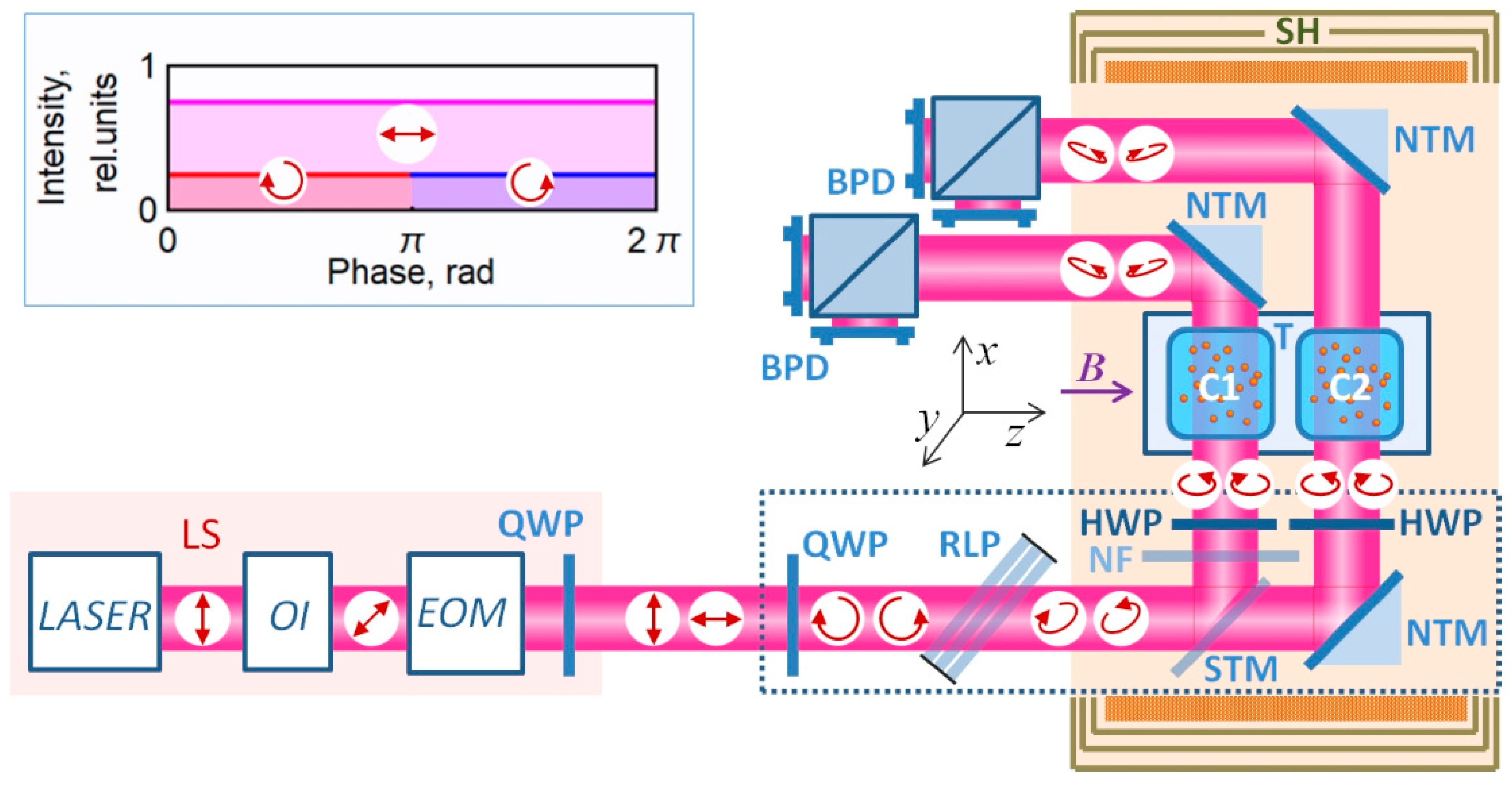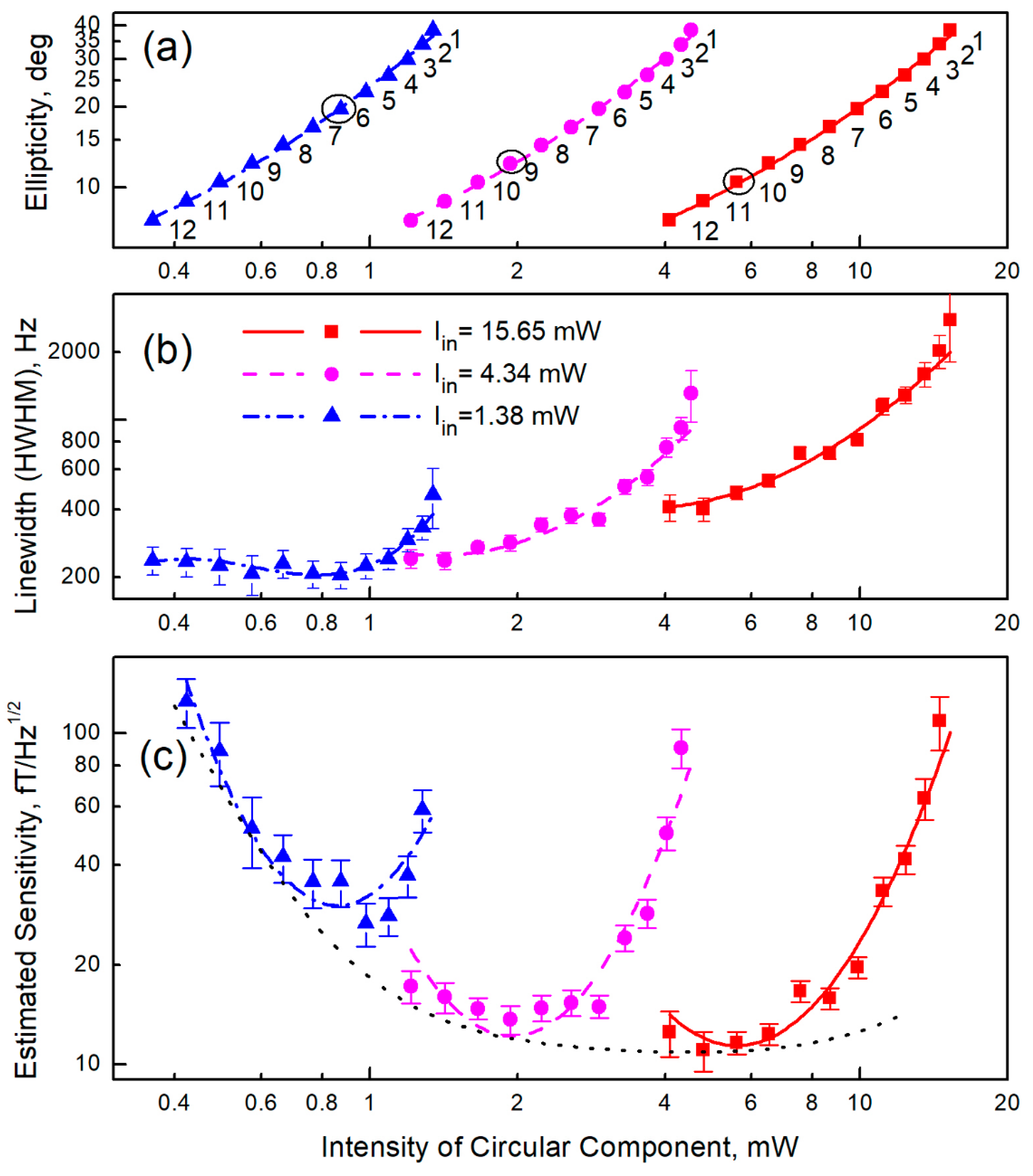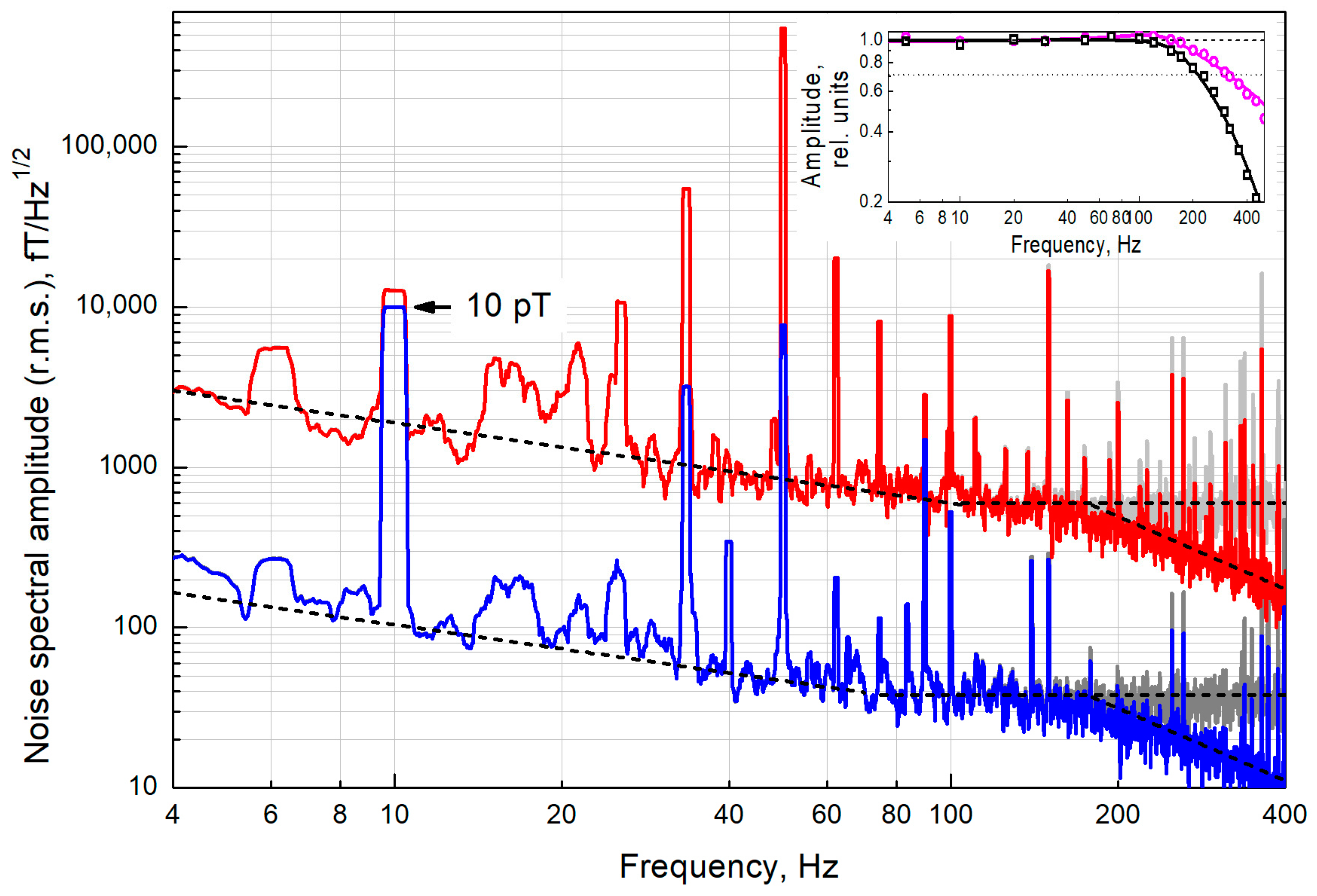Towards a Practical Implementation of a Single-Beam All-Optical Non-Zero-Field Magnetic Sensor for Magnetoencephalographic Complexes
Abstract
:1. Introduction
2. Materials and Methods
3. Results
4. Discussion
5. Conclusions
Author Contributions
Funding
Conflicts of Interest
Appendix A

References
- Hämäläinen, M.; Hari, R.; Ilmoniemi, R.J.; Knuutila, J.; Lounasmaa, O.V. Magnetoencephalography—Theory, Instrumentation, and Applications to Noninvasive Studies of the Working Human Brain. Rev. Mod. Phys. 1993, 65, 413–497. [Google Scholar] [CrossRef] [Green Version]
- Liang, A.; Wu, H.; Ma, Y.; Liang, X.; Jia, Y.; Gao, Y.; Ning, X.; Fang, J. Whole-Head Magnetoencephalogram and Its Application in Developmental Communication Disorders Research: A Review. IEEE Access 2021, 9, 42515–42532. [Google Scholar] [CrossRef]
- Dehmelt, H.G. Modulation of a Light Beam by Precessing Absorbing Atoms. Phys. Rev. 1957, 105, 1924–1925. [Google Scholar] [CrossRef]
- Bell, W.E.; Bloom, A.L. Optically Driven Spin Precession. Phys. Rev. Lett. 1961, 6, 280–281. [Google Scholar] [CrossRef]
- Budker, D.; Romalis, M. Optical Magnetometry. Nat. Phys. 2007, 3, 227. [Google Scholar] [CrossRef] [Green Version]
- Cohen, D. Magnetoencephalography: Detection of the Brain’s Electrical Activity with a Superconducting Magnetometer. Science 1972, 175, 664–666. [Google Scholar] [CrossRef]
- Marhl, U.; Jodko-Wladzińska, A.; Brühl, R.; Sander, T.; Jazbinšek, V. Transforming and Comparing Data between Standard SQUID and OPM-MEG Systems. PLoS ONE 2022, 17, e0262669. [Google Scholar] [CrossRef]
- Kominis, I.K.; Kornack, T.W.; Allred, J.C.; Romalis, M.V. A Subfemtotesla Multichannel Atomic Magnetometer. Nature 2003, 422, 596–599. [Google Scholar] [CrossRef]
- Iivanainen, J.; Stenroos, M.; Parkkonen, L. Measuring MEG Closer to the Brain: Performance of on-Scalp Sensor Arrays. NeuroImage 2017, 147, 542–553. [Google Scholar] [CrossRef]
- Boto, E.; Meyer, S.S.; Shah, V.; Alem, O.; Knappe, S.; Kruger, P.; Fromhold, T.M.; Lim, M.; Glover, P.M.; Morris, P.G.; et al. A New Generation of Magnetoencephalography: Room Temperature Measurements Using Optically-Pumped Magnetometers. NeuroImage 2017, 149, 404–414. [Google Scholar] [CrossRef]
- Tierney, T.M.; Holmes, N.; Mellor, S.; López, J.D.; Roberts, G.; Hill, R.M.; Boto, E.; Leggett, J.; Shah, V.; Brookes, M.J.; et al. Optically Pumped Magnetometers: From Quantum Origins to Multi-Channel Magnetoencephalography. NeuroImage 2019, 199, 598–608. [Google Scholar] [CrossRef]
- Boto, E.; Holmes, N.; Leggett, J.; Roberts, G.; Shah, V.; Meyer, S.S.; Muñoz, L.D.; Mullinger, K.J.; Tierney, T.M.; Bestmann, S.; et al. Moving Magnetoencephalography towards Real-World Applications with a Wearable System. Nature 2018, 555, 657. [Google Scholar] [CrossRef] [PubMed] [Green Version]
- Iivanainen, J.; Zetter, R.; Parkkonen, L. Potential of On-Scalp MEG: Robust Detection of Human Visual Gamma-Band Responses. Hum. Brain Mapp. 2020, 41, 150–161. [Google Scholar] [CrossRef] [PubMed] [Green Version]
- Nardelli, N.V.; Perry, A.R.; Krzyzewski, S.P.; Knappe, S.A. A Conformal Array of Microfabricated Optically-Pumped First-Order Gradiometers for Magnetoencephalography. EPJ Quantum Technol. 2020, 7, 11. [Google Scholar] [CrossRef]
- Rea, M.; Boto, E.; Holmes, N.; Hill, R.; Osborne, J.; Rhodes, N.; Leggett, J.; Rier, L.; Bowtell, R.; Shah, V.; et al. A 90-Channel Triaxial Magnetoencephalography System Using Optically Pumped Magnetometers. Ann. N. Y. Acad. Sci. 2022, 1517, 107–124. [Google Scholar] [CrossRef]
- Limes, M.E.; Foley, E.L.; Kornack, T.W.; Caliga, S.; McBride, S.; Braun, A.; Lee, W.; Lucivero, V.G.; Romalis, M.V. Portable Magnetometry for Detection of Biomagnetism in Ambient Environments. Phys. Rev. Appl. 2020, 14, 011002. [Google Scholar] [CrossRef]
- Guo, Y.; Wan, S.; Sun, X.; Qin, J. Compact, High-Sensitivity Atomic Magnetometer Utilizing the Light-Narrowing Effect and in-Phase Excitation. Appl. Opt. 2019, 58, 734–738. [Google Scholar] [CrossRef]
- Zhang, R.; Xiao, W.; Ding, Y.; Feng, Y.; Peng, X.; Shen, L.; Sun, C.; Wu, T.; Wu, Y.; Yang, Y.; et al. Recording Brain Activities in Unshielded Earth’s Field with Optically Pumped Atomic Magnetometers. Sci. Adv. 2020, 6, eaba8792. [Google Scholar] [CrossRef]
- Perry, A.; Bulatowicz, M.; Larsen, M.; Walker, T.; Wyllie, R. All-Optical Intrinsic Atomic Gradiometer with Sub-20 FT/Cm/√ Hz Sensitivity in a 22 ΜT Earth-Scale Magnetic Field. Opt. Express 2020, 28, 36696–36705. [Google Scholar] [CrossRef]
- Clancy, R.J.; Gerginov, V.; Alem, O.; Becker, S.; Knappe, S. A Study of Scalar Optically-Pumped Magnetometers for Use in Magnetoencephalography without Shielding. Phys. Med. Biol. 2021, 66, 175030. [Google Scholar] [CrossRef]
- Lucivero, V.; Lee, W.; Kornack, T.; Limes, M.; Foley, E.; Romalis, M. Femtotesla Nearly-Quantum-Noise-Limited Pulsed Gradiometer at Earth-Scale Fields. Phys. Rev. Appl. 2022, 18, L021001. [Google Scholar] [CrossRef]
- Fu, K.-M.C.; Iwata, G.Z.; Wickenbrock, A.; Budker, D. Sensitive Magnetometry in Challenging Environments. AVS Quantum Sci. 2020, 2, 044702. [Google Scholar] [CrossRef]
- Petrenko, M.V.; Dmitriev, S.P.; Pazgalev, A.S.; Ossadtchi, A.E.; Vershovskii, A.K. Towards the Non-Zero Field Cesium Magnetic Sensor Array for Magnetoencephalography. IEEE Sens. J. 2021, 21, 18626–18632. [Google Scholar] [CrossRef]
- Romalis, M.V. Optically Pumped Magnetometers for Biomagnetic Measurements. In Flexible High Performance Magnetic Field Sensors; Springer: Berlin/Heidelberg, Germany, 2022; pp. 3–15. [Google Scholar]
- Petrenko, M.V.; Pazgalev, A.S.; Vershovskii, A.K. Single-Beam All-Optical Non-Zero Field Magnetometric Sensor for Magnetoencephalography Applications. Phys. Rev. Appl. 2021, 15, 064072. [Google Scholar] [CrossRef]
- Petrenko, M.V.; Pazgalev, A.S.; Vershovskii, A.K. Ultimate Parameters of the All-Optical Single-Beam Non-Zero Magnetic Field Sensor for Biological Applications. IEEE Magn. Lett. 2021, 12, 8104605. [Google Scholar] [CrossRef]
- Schultze, V.; Schillig, B.; IJsselsteijn, R.; Scholtes, T.; Woetzel, S.; Stolz, R. An Optically Pumped Magnetometer Working in the Light-Shift Dispersed Mz Mode. Sensors 2017, 17, 561. [Google Scholar] [CrossRef] [PubMed] [Green Version]
- Bloom, A.L. Principles of Operation of the Rubidium Vapor Magnetometer. Appl. Opt. 1962, 1, 61–68. [Google Scholar] [CrossRef]
- Groeger, S.; Bison, G.; Schenker, J.-L.; Wynands, R.; Weis, A. A High-Sensitivity Laser-Pumped Mx Magnetometer. Eur. Phys. J. 2006, 38, 239–247. [Google Scholar] [CrossRef] [Green Version]
- Scholtes, T.; Schultze, V.; IJsselsteijn, R.; Woetzel, S.; Meyer, H.-G. Light-Narrowed Optically Pumped Mx Magnetometer with a Miniaturized Cs Cell. Phys. Rev. A 2011, 84, 043416. [Google Scholar] [CrossRef]
- Popov, E.N.; Bobrikova, V.A.; Voskoboinikov, S.P.; Barantsev, K.A.; Ustinov, S.M.; Litvinov, A.N.; Vershovskii, A.K.; Dmitriev, S.P.; Kartoshkin, V.A.; Pazgalev, A.S.; et al. Features of the Formation of the Spin Polarization of an Alkali Metal at the Resolution of Hyperfine Sublevels in the 2S1/2 State. JETP Lett. 2018, 108, 513–518. [Google Scholar] [CrossRef]
- Grujić, Z.D.; Weis, A. Atomic Magnetic Resonance Induced by Amplitude-, Frequency-, or Polarization-Modulated Light. Phys. Rev. A 2013, 88, 012508. [Google Scholar] [CrossRef] [Green Version]
- Appelt, S.; Ben-Amar Baranga, A.; Young, A.R.; Happer, W. Light Narrowing of Rubidium Magnetic-Resonance Lines in High-Pressure Optical-Pumping Cells. Phys. Rev. A 1999, 59, 2078–2084. [Google Scholar] [CrossRef] [Green Version]
- Vershovskii, A.K.; Pazgalev, A.S.; Petrenko, M.V. All-Optical Magnetometric Sensor for Magnetoencephalography and Ultralow Field Tomography. Tech. Phys. Lett. 2020, 46, 877–880. [Google Scholar] [CrossRef]
- Budker, D.; Kimball, D.F.; Rochester, S.M.; Yashchuk, V.V.; Zolotorev, M. Sensitive Magnetometry Based on Nonlinear Magneto-Optical Rotation. Phys. Rev. A 2000, 62, 043403. [Google Scholar] [CrossRef] [Green Version]
- Budker, D.; Gawlik, W.; Kimball, D.F.; Rochester, S.M.; Yashchuk, V.V.; Weis, A. Resonant Nonlinear Magneto-Optical Effects in Atoms. Rev. Mod. Phys. 2002, 74, 1153–1201. [Google Scholar] [CrossRef] [Green Version]
- Wu, T.; Peng, X.; Chen, J.; Guo, H. Fiber-Coupled OPM in Purely Coil-Shielded Environment. In Flexible High Performance Magnetic Field Sensors; Springer: Berlin/Heidelberg, Germany, 2022; pp. 161–177. [Google Scholar]
- Vershovskii, A.K.; Petrenko, M.V. Optical Magnetometric Sensor for Operation in Magnetoencephalographic Complexes. Tech. Phys. Lett. 2022; to be printed. [Google Scholar]
- Kaminow, I. Polarization-Maintaining Fibers. Appl. Sci. Res. 1984, 41, 257–270. [Google Scholar] [CrossRef]
- Vershovskii, A.K.; Petrenko, M.V. Methods of Parametric Resonance Excitation in the Scheme of an Optical Magnetometric Sensor. Tech. Phys. 2022, 66, 821–826. [Google Scholar] [CrossRef]
- Savenkov, S.N. Jones and Mueller Matrices: Structure, Symmetry Relations and Information Content. In Light Scattering Reviews 4: Single Light Scattering and Radiative Transfer; Kokhanovsky, A.A., Ed.; Springer: Berlin/Heidelberg, Germany, 2009; pp. 71–119. ISBN 978-3-540-74276-0. [Google Scholar]
- Born, M.; Wolf, E. Principles of Optics: Electromagnetic Theory of Propagation, Interference and Diffraction of Light; Elsevier: Amsterdam, The Netherlands, 2013. [Google Scholar]
- Lee, S.-K.; Romalis, M. Calculation of Magnetic Field Noise from High-Permeability Magnetic Shields and Conducting Objects with Simple Geometry. J. Appl. Phys. 2008, 103, 084904. [Google Scholar] [CrossRef]




Publisher’s Note: MDPI stays neutral with regard to jurisdictional claims in published maps and institutional affiliations. |
© 2022 by the authors. Licensee MDPI, Basel, Switzerland. This article is an open access article distributed under the terms and conditions of the Creative Commons Attribution (CC BY) license (https://creativecommons.org/licenses/by/4.0/).
Share and Cite
Petrenko, M.; Vershovskii, A. Towards a Practical Implementation of a Single-Beam All-Optical Non-Zero-Field Magnetic Sensor for Magnetoencephalographic Complexes. Sensors 2022, 22, 9862. https://doi.org/10.3390/s22249862
Petrenko M, Vershovskii A. Towards a Practical Implementation of a Single-Beam All-Optical Non-Zero-Field Magnetic Sensor for Magnetoencephalographic Complexes. Sensors. 2022; 22(24):9862. https://doi.org/10.3390/s22249862
Chicago/Turabian StylePetrenko, Mikhail, and Anton Vershovskii. 2022. "Towards a Practical Implementation of a Single-Beam All-Optical Non-Zero-Field Magnetic Sensor for Magnetoencephalographic Complexes" Sensors 22, no. 24: 9862. https://doi.org/10.3390/s22249862





